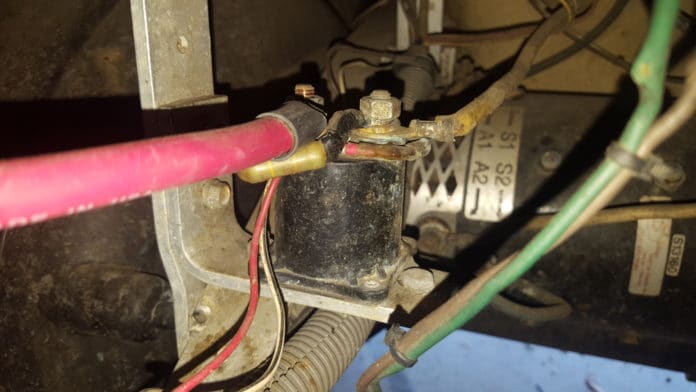
What does a Golf Cart Solenoid do?
Before trying to understand the symptoms of a solenoid going bad in golf carts, let’s review what they are supposed to do when operating properly.
Technically, in fact, a solenoid is a shape – a shape in which the length of something coiled is longer than the diameter of the coils. In engine starters, this refers to the smaller motor that piggybacks on the starter … as that smaller motor contains a wire coiled many times around a metal bar.
For a gas golf cart, the function of the solenoid in a golf cart motor is to use a small amount of electricity (made possible by turning on the ignition switch) to close two heavy-duty contacts that are needed to get the starter turning over. It also functions in the same way with an electric golf cart.
Step by step, it looks like this:
When you turn the ignition key, a small amount of electricity goes to the solenoid. The solenoid uses that small amount of juice to close two heavy-duty contacts that allows a large jolt of electricity to pass through the starter. The solenoid also sends a pinion gear forward, which is the device the starter uses to turn over the flywheel. Once the engine engages, a spring brings the pinion gear back to the starter, where it remains idle until you need to restart the engine at some point.
So, in review, the solenoid does two things:
- It acts as a switch that permits a large amounts of juice to go to the starter.
- And it acts as a mechanical device that puts the starter pinion gear into position, so when the starter turns over it will be engaged with the flywheel just long enough for the engine to catch.
For an electric golf cart, it functions in the same way, however there is no starter. The solenoid is simply there to allow electricity to flow freely to the controller and motor which will result in a running golf cart.
RELATED: 4 Signs you need to Replace your Golf Cart Batteries
What are the symptoms of a bad solenoid on a golf cart?
In a gas golf cart, the larger contacts could fail to release, which means the starter will be operating even if you turn the ignition switch to off. In addition, the spring that pulls the pinion back to its resting position could wear down leaving the starter engaged continuously. (Starters are supposed to get the flywheel moving, then back out of position – disengage.)
Like any switch that relies on wiring, the solenoid could also just wear out due to overheating. This might cause it to fail to retrieve the pinion gear.
Knowing that, when the solenoid starts failing, how do you know it and what’s going on?
On a gas golf cart, the most common symptom is the starter failing to engage – so the engine doesn’t turn over – while all you hear a series of very futile clicking sounds.
On an electric golf cart, the most common symptom is the solenoid is not delivering electricity to the controller when the vehicle’s ignition is turned on. In normal operating conditions, the solenoid clicks on and off with the ignition switch. A failing solenoid will generally not click.
Two things could be going on here. The solenoid might not be getting enough electricity to do its work – which could be caused by loose connections, a weak battery or the coil wearing out.
Secondly, the contacts could begin to wear out from overheating or exposure to high levels of current. This needs to be fixed right away if possible, because this causes continuous use of the starter. If not caught in time, the solenoid and the starter will both need replacement.
How to test for a bad solenoid in your golf cart
If you’re a do-it-yourself-er (of course you are), here’s what you can do.
Before starting work, a couple of items/tools will be recommended prior to starting. The list is as follows:
First rule here: when you test the starting system, first disconnect the cables that go to the larger solenoid terminals from the starter (gas) or controller (electric). When you do this, use electrical tape to seal the cable ends, so they won’t form a circuit by accidentally touching each other or connecting through a metal conductor inadvertently. Doing this will ensure the vehicle will not run while testing the solenoid.
Once you’ve disconnected the cables safely – using your multimeter – use the voltmeter on the ohms setting and touch each large terminal with the probes with the key turned off. You should get a zero reading.
Now try the same thing with the key on and the cart set to forward travel (not reverse).
Step on the gas and listen for a clicking sound.
If you get a clicking sound, look for a reading of less than 0.4 ohms. If the reading is higher, the solenoid is not working and needs to be replaced.
On an electric golf cart, if the solenoid is silent – no clicking – use the setting voltmeter to DC volts using the 200 range. First, turn on the ignition while looking for a reading on the smaller terminals. If nothing is appearing, then press on the accelerator. If the needle doesn’t move, then the problem is not with the solenoid. If it jumps and displays full voltage, then the solenoid is the problem and should be replaced with a new one.
We hope this article has helped you understand the symptoms of a bad solenoid on a golf cart. If you have any questions please feel free to ask them in the comments below.
Here is a video to help you
Frequently Asked Questions
What is the cost of a Yamaha Quiet Tech golf cart?
The cost of a Yamaha Quiet Tech golf cart can vary based on several factors, including the model year, features, and any additional customization options you may choose. Discover the Yamaha Quiet Tech golf cart price and explore the various options available for your ideal golf cart. If you’re interested in purchasing a Yamaha Quiet Tech golf cart, you can explore different listings and dealers to find the one that suits your preferences and budget.
What are the symptoms of a bad solenoid on a golf cart?
A solenoid plays a crucial role in the electrical system of your golf cart, including the Club Car DS Electric. When the solenoid goes bad, it can disrupt the flow of electricity needed to engage the cart’s starter motor, resulting in the symptoms mentioned above. To address this, it’s recommended to have a professional technician inspect and potentially replace the solenoid. If you’re looking for Club Car DS Electric models for sale, you can explore a variety of inventory from dealers on our website and find the perfect fit for your needs.
Are there any other options for golf carts with solenoid issues?
If you’re experiencing solenoid problems in your golf cart, we’ve got you covered. Alongside understanding the symptoms of a faulty solenoid, we provide a broad range of solutions, including expert advice and access to reputable dealers. We also offer a diverse selection of golf carts for sale from various highly reputable golf cart dealers in case you need a replacement.
How do I recognize symptoms of a bad solenoid on a golf cart, especially a gas-powered Moke?
Identifying symptoms of a faulty solenoid in your golf cart, especially a gas-powered Moke, is crucial to maintaining its optimal performance. If you’re experiencing issues like a clicking sound when trying to start, but the engine doesn’t turn over, or if you notice intermittent starting problems, it could be indicative of a failing solenoid. Additionally, a gas-powered Moke that jerks or lurches during startup might be exhibiting solenoid-related problems. Visit knowledgeable technicians or experts who can accurately diagnose the issue and suggest appropriate solutions to resolve it. If you are looking for a golf cart dealer to help you, go to our website and find the nearest service provider.
What should I do if I suspect a bad solenoid on my golf cart near Ohio?
If you’re experiencing issues that align with the symptoms of a bad solenoid on a golf cart near Ohio, it’s crucial to address the problem promptly. One of the steps you can take is to consult reputable golf cart dealers in Ohio. These dealers are experienced in diagnosing and resolving such problems. They can provide expert guidance on whether the solenoid is indeed faulty and advise you on the necessary repairs or replacements. If you’re located in Ohio and are in need of assistance, reach out to golf cart dealers in Ohio to ensure that your golf cart gets the attention it requires.
What are the symptoms of a bad solenoid on an EZGO golf cart?
If you’re experiencing issues with your EZGO golf cart, a faulty solenoid could be the culprit. When the solenoid goes bad, you might notice that the cart doesn’t start or has difficulty getting moving. You might hear a clicking sound when you try to start it, but the cart won’t engage. Additionally, if the solenoid is malfunctioning, the cart might suddenly stop while in operation. If you’re encountering any of these problems with your EZGO golf cart, it’s a good idea to have it checked and possibly replaced to ensure smooth operation. For a wide range of EZGO golf carts for sale, including the popular TXT model, you can explore dealer options on our platform.








I have a 2011 Yamaha cart, runs good for about 3 minutes, then dies. I switch tow switch off then on it runs again but for 3 minutes.
Flywheel? Starter pinion? On a golf cart?
I have an EZGo golf cart. After taking brake off and pressing on gas
Pedal,left rear tire does not turn and right rear tire spins. It does not move. My cart is battery powered. What’s wrong?
I have a 96 club car gas operated I just put a new coil in it that was sparking wheel good and it did stop then it died out again and now I’m not getting no spot what is the problem what could it be
I have a 2014 Club Car that I just replace the batteries with lithium batteries. Cart had been working fine for about a month but now it will not go forward or reverse. The reverse beeps doesn’t even come on. I have replaced the forward and reverse switch and the MCOR on my cart. Any suggestions before I purchase a new controller.
When I press on the accelerator nothing happens. No clicking noise. Battery is functional. Spark plugs are good batterie connects are good. Anyone had this issue? Any ideas?
Good day to everyone,
We do our best here at Golf Cart Resource to provide education on Golf Carts, however if you find yourself stuck in the repair process, then we would highly recommend reaching out to your local dealer as it is increasingly difficult to diagnose issues without be directly in front of the unit. Under the resources tab at the top of the page, you can find a dealer locator which will help you find a dealer near you.
I have a G1 early 80’s cart. I believe a 81, looking up the serial number on the cart. Ran fine until I put it up last year and battery went dead. I put a quick battery starter on it to move it and it cranked but never fully started after pushing the gas down. Took the battery off to charge and put it back on the cart. When I push the peddle down to start all it did was click once and won’t do anything now. Completely dead. And advice?
My Electric golfcart has a smell while driving it,I checked the batteries and all water levels were above the metal. I added water to those that needed a little. While out driving the cart it died. No forward motion.
John,
Your unit is most likely dealing with a battery issue over a solenoid issue. We would recommend contacting a local dealer for assistance.
I wanted to compliment you on how well you explained the solenoid problem. Good job on the website. Solenoid was not my problem so still looking. Thanks
Starter pinion gear does not exist on a golf cart, what is this, did see someone copy and paste from a Chilton’s Pinto Manual. A golf cart solenoid is a switch that allows the small gauge circuit to send a signal to the large gauge wires operating the Starter, no more no less.
Does anyone have a micro switch diagram for a1989 shuttlecraft golf cart? The engine only runs when kill wire is unhooked. I put on a new coil. I don’t understand how the top micro switch can operate the bottom micro switch.
When the kill wire is unhooked the engine of course will not shut off
I am not mechanically inclined at all. Some mornings when I go to use my golf cart it just clicks for about 5 minutes when it catches its fine for the round. Then again some mornings it starts right up and is good for the day. Any help Thanks